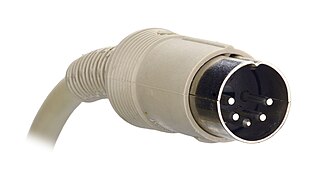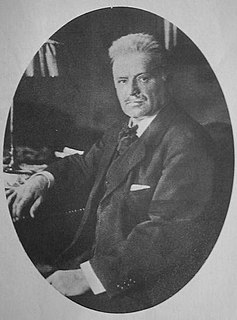
The Compact Cassette or Musicassette (MC), also commonly called the tape cassette, cassette tape, audio cassette, or simply tape or cassette, is an analog magnetic tape recording format for audio recording and playback. Invented by Lou Ottens and his team at the Dutch company Philips in 1963, Compact Cassettes come in two forms, either already containing content as a prerecorded cassette (Musicassette), or as a fully recordable "blank" cassette. Both forms have two sides and are reversible by the user. Although other tape cassette formats have also existed - for example the Microcassette - the generic term cassette tape is normally always used to refer to the Compact Cassette because of its ubiquity.

An audio tape recorder, also known as a tape deck, tape player or tape machine or simply a tape recorder, is a sound recording and reproduction device that records and plays back sounds usually using magnetic tape for storage. In its present-day form, it records a fluctuating signal by moving the tape across a tape head that polarizes the magnetic domains in the tape in proportion to the audio signal. Tape-recording devices include the reel-to-reel tape deck and the cassette deck, which uses a cassette for storage.
A cassette deck is a type of tape machine for playing and recording audio cassettes that does not have a built-in power amplifier or speakers, and serves primarily as a transport. It can be a part of an automotive entertainment system, a part of a portable mini system or a part of a home component system. In the latter case it is also called a component cassette deck or just a component deck.

Ampex is an American electronics company founded in 1944 by Alexander M. Poniatoff as a spin-off of Dalmo-Victor. The name AMPEX is a portmanteau, created by its founder, which stands for Alexander M. Poniatoff Excellence. Today, Ampex operates as Ampex Data Systems Corporation, a subsidiary of Delta Information Systems, and consists of two business units. The Silicon Valley unit, known internally as Ampex Data Systems (ADS), manufactures digital data storage systems capable of functioning in harsh environments. The Colorado Springs, Colorado unit, referred to as Ampex Intelligent Systems (AIS), serves as a laboratory and hub for the company's line of industrial control systems, cyber security products and services and its artificial intelligence/machine learning technology.

Reel-to-reel audio tape recording, also called open-reel recording, is magnetic tape audio recording in which the recording tape is spooled between reels. To prepare for use, the supply reel containing the tape is placed on a spindle or hub. The end of the tape is manually pulled from the reel, threaded through mechanical guides and over a tape head assembly, and attached by friction to the hub of the second, initially empty takeup reel. Reel-to-reel systems use tape that is 1⁄4, 1⁄2, 1, or 2 inches wide, which normally moves at 3+3⁄4, 7+1⁄2, 15 or 30 inches per second. All standard tape speeds are derived as a binary submultiple of 30 inches per second.
Nakamichi Corp., Ltd. is a Japanese consumer electronics brand that originated in Japan and gained a name from the 1970s onwards for innovative and high quality audio cassette decks. Nakamichi is a subsidiary of Chinese holding company Nimble Holdings.

The DIN connector is an electrical connector that was originally standardized in the early 1970s by the Deutsches Institut für Normung (DIN), the German national standards organization. There are DIN standards for various different connectors.

Wire recording or magnetic wire recording was the first magnetic recording technology, an analog type of audio storage in which a magnetic recording is made on a thin steel wire. The first crude magnetic recorder was invented in 1898 by Valdemar Poulsen. The first magnetic recorder to be made commercially available anywhere was the Telegraphone, manufactured by the American Telegraphone Company, Springfield, Massachusetts in 1903.

Valdemar Poulsen was a Danish engineer who made significant contributions to early radio technology. He developed a magnetic wire recorder called the telegraphone in 1898 and the first continuous wave radio transmitter, the Poulsen arc transmitter, in 1903, which was used in some of the first broadcasting stations until the early 1920s.
Blaupunkt GmbH was a German manufacturer of mostly car audio equipment. It was owned by Robert Bosch GmbH from 1933 until 1 March 2009, when it was sold to Aurelius AG of Germany. It filed for bankruptcy in late 2015 with liquidation proceedings completed in early 2016. The brand is now managed by GIP Development SARL of Luxembourg and is used on various product groups worldwide.
TEAC Corporation is a Japanese electronics manufacturer. TEAC was created by the merger of the Tokyo Television Acoustic Company, founded in 1953, and the Tokyo Electro-Acoustic Company, founded in 1956.

Sound recording and reproduction is the electrical, mechanical, electronic, or digital inscription and re-creation of sound waves, such as spoken voice, singing, instrumental music, or sound effects. The two main classes of sound recording technology are analog recording and digital recording.
The history of sound recording - which has progressed in waves, driven by the invention and commercial introduction of new technologies — can be roughly divided into four main periods:

Magnetophone, or simply Magnetophon, was the brand or model name of the pioneering reel-to-reel tape recorder developed by engineers of the German electronics company AEG in the 1930s, based on the magnetic tape invention by Fritz Pfleumer. AEG created the world's first practical tape recorder, the K1, first demonstrated in Germany in 1935 at the Berlin Radio Show.

A videocassette recorder (VCR) or video recorder is an electromechanical device that records analog audio and analog video from broadcast television or other source on a removable, magnetic tape videocassette, and can play back the recording. Use of a VCR to record a television program to play back at a more convenient time is commonly referred to as timeshifting. VCRs can also play back prerecorded tapes. In the 1980s and 1990s, prerecorded videotapes were widely available for purchase and rental, and blank tapes were sold to make recordings.

Music Center Incorporated (MCI) is the former name of a United States manufacturer of professional audio equipment that operated from 1955 until 1982 when it was acquired by the Sony Corporation. The company is credited with a number of world firsts: commercialising the 24-track multi-track recorder, the tape Auto Locator and in-line mixing console.

Electric music technology refers to musical instruments and recording devices that use electrical circuits, which are often combined with mechanical technologies. Examples of electric musical instruments include the electro-mechanical electric piano, the electric guitar, the electro-mechanical Hammond organ and the electric bass. All of these electric instruments do not produce a sound that is audible by the performer or audience in a performance setting unless they are connected to instrument amplifiers and loudspeaker cabinets, which made them sound loud enough for performers and the audience to hear. Amplifiers and loudspeakers are separate from the instrument in the case of the electric guitar, electric bass and some electric organs and most electric pianos. Some electric organs and electric pianos include the amplifier and speaker cabinet within the main housing for the instrument.
Bernard August Cousino was an American music technology inventor. He is known for inventing an endless loop tape cartridge design in 1952, known as the Audio Vendor, patented under US2804401A. The tape is pulled from the inside of a loose tape roll making it spin to wind the returning tape onto the roll again. Initially, this mechanism was mounted on a reel to reel tape recorder. Later Cousino developed a plastic housing to be hung up on some tape recorders. First, the magnetic coating was wound to the inside of the reel. This cartridge was marketed by John Herbert Orr as the Orrtronic Tapette. Newer cartridges had magnetic coating wind of the tape outside the reel, which required a special recorder to operate it, but offers comfortable simple inserting the cartridge without threading the tape. This more compact cartridges do not require any bottom spare for the tape head assembly. That would inspire George Eash to make the Fidelipac tape cartridge, which itself would inspire the Stereo-Pak tape cartridge.
An endless tape cartridge is a tape cartridge or cassette that contains magnetic audio tape that can be played in an endless loop, without the need to rewind to repeat.












